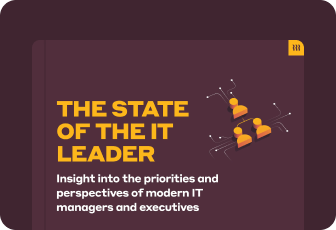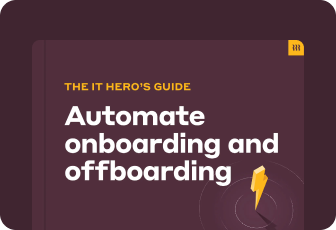Identity and Access Management (IAM) is a framework of policies and technologies that ensures the right individuals have appropriate access to resources and systems within an organization. It helps secure sensitive information by managing user identities and controlling access permissions.
What is IAM and how does it work?
IAM is all about managing and securing digital identities. A digital identity is a unique representation of a user or entity within a system, such as an employee, customer, partner, or device. Each identity has a set of attributes, credentials, and permissions associated with it that determine what actions it can perform and what resources it can access.
IAM works by authenticating users and verifying their identities against an identity management database, which contains identity information such as employee names, job titles, personal email addresses, etc. Access management then authorizes users to access specific resources based on their roles, permissions, and other relevant factors, ensuring that only authorized individuals can access sensitive data and systems.
When IT teams are tasked with managing countless user accounts, permissions, and access rights across various systems and applications, it can feel like an uphill battle. Without a solid IAM solution in place, IT professionals often find themselves trapped in a never-ending cycle of manually provisioning, modifying, and revoking user access. This tedious and time-consuming process not only eats away at productivity but also increases the risk of security issues caused by human error or unauthorized access.
As businesses grow and evolve, the need for a scalable and efficient IAM solution becomes increasingly apparent. With employees constantly joining, leaving, or shifting roles within the organization, it's important to ensure that the right people have access to the right resources at the right time. Failing to do so can open the door to data leaks, compliance issues, and a murky understanding of who has their hands on sensitive information. The costs can add up quickly, which explains why IAM is critical for businesses today.
Here's a real-world scenario: Consider a situation where you need to pick up a prescription medication from the pharmacy. You (the user) visit the pharmacy to collect your medication (the resource you want to access). The pharmacist asks for your ID and prescription (authenticates your identity) and verifies that the prescription is valid and issued in your name (checks your attributes) before providing you with the medication (authorizes the transaction). IAM operates on a similar principle, granting access to resources only when the appropriate conditions are met.
Why IAM matters more than ever
In the past, managing user access was a lot simpler. Most people worked in the office, using company-issued computers, and accessing resources on the local network behind a corporate firewall. But those days are long gone. Now, organizations are embracing cloud-based services, mobile devices, and remote work arrangements. The traditional network perimeter has practically disappeared, and users are accessing corporate resources from anywhere, at any time, using a variety of devices and platforms.
While this flexibility is great for productivity, it also opens up a whole new world of security risks. The attack surface is bigger than ever, and the threat of unauthorized access, data breaches, and insider attacks keeps IT teams up at night. That's where IAM comes in. It helps organizations fight off these threats by establishing a strong foundation for secure user access.
When you implement IAM, you can:
- Ensure that only authorized users can access sensitive data and resources
- Apply consistent access policies across all systems and applications, regularly auditing them to ensure they remain appropriate
- Streamline the process of setting up and removing user accounts
- Enable secure remote access for employees and partners
- Comply with industry regulations and data privacy laws
- Give users a better experience with single sign-on (SSO) and self-service options
With numerous organizations adopting a zero trust security model that relies heavily on robust IAM practices, these solutions can help manage access to a wide range of resources, including IoT devices and on-demand SaaS applications. Many IAM professionals pursue relevant certifications to demonstrate their expertise in this critical field.
The cost of poor IAM practices
Neglecting IAM can have severe consequences for organizations, both in terms of security and financial impact. According to the 2023 Cost of a Data Breach Report by IBM and the Ponemon Institute, the average total cost of a data breach reached $4.45 million, with compromised credentials being the most common initial attack vector.
But the costs don't stop there. Poor IAM practices can also lead to operational inefficiencies, decreased productivity, and a frustrating user experience. When users struggle to access the resources they need or have to remember multiple passwords for different systems, it not only slows them down but also makes them more likely to resort to insecure workarounds like writing passwords on sticky notes or sharing them with colleagues. It's a recipe for disaster that creates a perfect storm of potential losses that no organization can afford to ignore.
The building blocks of IAM
To understand how IAM works, it's essential to familiarize yourself with its core components and concepts. Let's take a closer look at the key building blocks of a comprehensive IAM solution:
User provisioning and de-provisioning
User provisioning is the process of creating, modifying, and managing user accounts across various systems and applications. This includes assigning appropriate access rights, roles, and permissions based on the user's job function and organizational policies. Provisioning can be done manually by administrators or automated through integrations with HR systems and identity management tools.
De-provisioning, on the other hand, is the process of revoking user access when it's no longer needed, such as when an employee leaves the organization or changes roles. Timely and accurate de-provisioning is crucial for maintaining security and preventing unauthorized access by former employees or contractors.
Authentication and authorization
Authentication is the process of verifying a user's identity to ensure they are who they claim to be. This typically involves the use of credentials, such as usernames and passwords, biometric data, or security tokens. Multi-factor authentication (MFA) adds an extra layer of security by requiring users to provide additional proof of identity, such as a one-time code sent to their mobile device.
Authorization, on the other hand, is the process of granting or denying access to specific resources based on the user's authenticated identity and assigned permissions. This ensures that users can only access the data and functionality they are explicitly allowed to, in accordance with the organization's access control policies.
Single sign-on (SSO) and federation
Single sign-on (SSO) allows users to access multiple applications and services with a single set of credentials. By eliminating the need for users to remember and manage multiple usernames and passwords, SSO improves the user experience and reduces the risk of password fatigue and insecure password practices.
Federation extends the concept of SSO by enabling users to access resources across different organizations or domains. This is achieved through trust relationships established between the identity providers (IdPs) and service providers (SPs) involved. Common federation protocols include Security Assertion Markup Language (SAML), OAuth, and OpenID Connect (OIDC).
Access control models
Access control models define how access rights are granted and enforced within an organization. Access control is a critical component of the Zero Trust security model. In a Zero Trust environment, access control goes beyond traditional perimeter-based security measures. It operates on the principle of “never trust, always verify”, continuously evaluating the trustworthiness of every user, device and network flow before granting access to resources.
The most common access control models include:
- Role-Based Access Control (RBAC): Users are assigned to roles based on their job functions, and access rights are granted to those roles rather than individual users.
- Attribute-Based Access Control (ABAC): Access decisions are based on attributes associated with users, resources, and environmental conditions, allowing for more granular and dynamic access control.
- Discretionary Access Control (DAC): Resource owners have the ability to grant or revoke access to their resources at their discretion.
- Mandatory Access Control (MAC): Access is controlled by a central authority based on predefined security labels assigned to users and resources.
Auditing and reporting
Auditing and reporting are essential for maintaining visibility into user activities, detecting potential security incidents, and demonstrating compliance with regulatory requirements. IAM solutions should provide comprehensive logging and reporting capabilities, including:
- User activity logs: Track user logins, access attempts, and resource usage across all managed systems and applications.
- Access review reports: Regularly review and validate user access rights to ensure they are still appropriate and necessary.
- Compliance reports: Generate reports that demonstrate adherence to industry standards and regulations, such as HIPAA, PCI DSS, and GDPR.
The IAM lifecycle: From onboarding to offboarding
IAM is not a one-and-done deal. It's a continuous process that spans the entire lifecycle of a user's relationship with your organization. From the moment a new employee joins the company to the day they leave, IAM plays a critical role in ensuring that they have the right access at the right time.
Let's take a closer look at the key stages of the IAM lifecycle:
Onboarding
When a new user joins the organization, the first step is to create their digital identity and grant them the necessary access to perform their job. This is where the provisioning process comes into play.
As discussed already, provisioning involves creating user accounts, assigning roles and permissions, and configuring access to various systems and applications. Traditionally, this was done manually by IT staff, but modern identity access management systems offer automated provisioning capabilities that can significantly streamline the process.
For example: When a new employee is added to the HR system, an IAM solution can automatically create their user account, assign them to the appropriate groups and roles based on their job function, and grant them secure access to the necessary applications and resources. This not only saves time and reduces the workload on IT staff but also ensures that new users have the access they need from day one.
Access modification
As users move through their careers, their access needs are likely to change. They may take on new roles, change departments, or require access to additional systems and applications. IAM solutions need to be able to handle these changes in a timely and efficient manner. This is where access modification comes into play.
Access modification involves adjusting a user's permissions and access rights as their job responsibilities evolve. This could involve adding them to new groups or roles, granting them access to additional resources, or revoking access that is no longer necessary. Again, modern IAM solutions can automate much of this process.
For example: If a user is promoted to a new role, the IAM system can automatically update their permissions based on predefined policies or approval workflows. The key is to ensure that access modification is an ongoing process, not a one-time event. Regular access reviews should be conducted to ensure that users' permissions remain aligned with their current job requirements. This helps identify and remove any excessive or outdated permissions that could pose a cybersecurity risk.
Offboarding
When a user leaves the organization or no longer requires access to certain resources, it's critical to revoke their access in a timely manner. This is known as access termination or de-provisioning. This process should be initiated as soon as a user's employment ends or their access is no longer required.
Failure to de-provision users promptly can leave your organization vulnerable to insider threats and data breaches. A disgruntled ex-employee with lingering access could potentially steal sensitive data, sabotage systems, or engage in other malicious activities.
Modern IAM solutions can automate the de-provisioning process by integrating with HR systems and other authoritative sources. When a user is marked as terminated in the HR system, the IAM solution can automatically revoke their access and disable their accounts across all connected systems.
Best practices for implementing IAM
Implementing a successful IAM solution requires careful planning, execution, and ongoing management. Here are some best practices to keep in mind:
Start with a clear strategy
Before you dive into the technical details, take the time to define your IAM strategy. What are your goals and objectives? What are your key use cases and requirements? What are your constraints and dependencies?
Answering these questions upfront will help you prioritize your efforts, choose the right solutions, and avoid common pitfalls. It will also ensure that your IAM initiatives are aligned with your overall business strategy and deliver measurable value to the organization.
Embrace the principle of least privilege
One of the fundamental tenets of IAM is the principle of least privilege. This means granting users the minimum level of access necessary to perform their job functions and nothing more. By default, users should have no access to any resources. Access should be granted on a need-to-know basis, based on well-defined roles and permissions.
And as users' needs change over time, their access should be continually reviewed and adjusted to ensure that it remains appropriate and necessary. Embracing the principle of least privilege can significantly reduce your attack surface, limit the potential impact of security breaches, and make it easier to manage access over time.
Implement strong authentication
Authentication is the foundation of any IAM solution. It's the process of verifying that users are who they claim to be before granting them access to any resources. While usernames and passwords are still the most common form of authentication, they are also the most vulnerable. Weak, reused, or compromised passwords are a leading cause of data breaches and cyber attacks.
To strengthen your authentication process, consider implementing multi-factor authentication for all users. MFA requires users to provide additional proof of identity beyond just a password, such as a one-time code sent to their mobile device or a biometric factor like a fingerprint or facial recognition. It can enhance data security and reduce the risk of unauthorized access, even if a user's password is compromised.
Educate and involve your users
IAM is not just a technical problem; it's also a people problem. No matter how robust your IAM tool is, it's only as effective as the users who interact with it. That's why it's essential to educate and involve your users in your IAM efforts. Help them understand the importance of strong passwords, the risks of sharing credentials, and the benefits of self-service capabilities like password reset and access requests.
Encourage users to report suspicious activities or potential security incidents, and provide clear channels for them to do so. And involve them in the access review and attestation process to ensure that their permissions remain appropriate and necessary over time. By doing this, you can significantly reduce the risk of human error and insider threats, while also improving the user experience and adoption of your IAM solution.
Monitor and measure
IAM is not a set-it-and-forget-it endeavor. It requires ongoing monitoring and measurement to ensure that it remains effective and aligned with your evolving needs and risks. Establish clear metrics and KPIs to track the success of your IAM program. This could include metrics like the percentage of users with MFA enabled, the time to provision and deprovision accounts, the number of orphaned or inactive accounts, and the frequency and results of access reviews.
Use automated monitoring and alerting tools to detect and respond to potential security incidents or policy violations in real-time. And conduct regular assessments and audits to identify gaps or weaknesses in your IAM controls and processes. By continuously monitoring and measuring your IAM program, you can proactively identify and mitigate risks, demonstrate regulatory compliance with internal and external requirements, and make data-driven decisions about where to invest your resources and efforts.
Automate and integrate
Managing IAM manually can be a time-consuming and error-prone process, particularly in large organizations with complex IT environments. To streamline your IAM efforts and reduce the risk of human error, look for opportunities to automate and integrate your IAM processes wherever possible.
For example, you can use automated provisioning tools to create and manage user accounts based on predefined policies and workflows. You can integrate your IAM solution with your HR system to automatically grant and revoke access as users join, move, or leave the organization. And you can use APIs and connectors to extend your IAM capabilities to cloud applications and other external systems.
This helps to reduce the workload on your IT staff, improve the consistency and accuracy of your access policies, and respond more quickly to changes in your user population. Fortunately, Rippling makes it easy to automate and integrate your IAM processes.
Discover how Rippling can help with identity and access management
Rippling streamlines identity and access management by unifying employee data across HR and IT systems, enabling powerful automation that eliminates tedious manual work. With Rippling, you can automate user provisioning and deprovisioning, role-based access control, SSO configuration, and more—all based on real-time employee data. No more worrying about access rights falling out of sync when roles change or employees leave.
Rippling is also the only workforce platform to combine IAM, device management, and inventory management in one system, allowing you to handle all your employee IT needs from a single place. This allows you to order and configure devices, manage app access, and even automatically deprovision accounts and retrieve devices when offboarding, all in a few clicks. This helps keep your workforce secure and compliant, while saving you time, headaches and money compared to juggling multiple point solutions.
With Rippling, you can:
- Enforce consistent, role-based access policies across all your apps and systems
- Easily connect 500+ apps with pre-built integrations including Google Workspace, AWS, Slack and Microsoft 365, for SSO, user provisioning, and more
- Always keep app access and group memberships in sync with your current org structure
- Provide employees with secure, one-click access to all their apps through the Rippling SSO portal
- Implement granular access rules based on any employee attribute, such as location, department, or custom fields
- Schedule precise dates and times for account deprovisioning and device wiping during offboarding
- Pull detailed access reports and audit logs in just a few clicks for compliance and security reviews
Frequently asked questions
What is customer identity and access management (CIAM)?
CIAM is a framework that enables organizations to manage and secure customer identities and access to digital services. CIAM solutions provide features such as user registration, authentication, authorization, and profile management to deliver seamless and secure customer experiences.
What’s the difference between cloud IAM and on-premises IAM?
When it comes to IAM solutions, you have two main options: cloud IAM and on-prem IAM. Cloud IAM offers the benefits of scalability, flexibility, and reduced maintenance, as the solution is hosted and managed by a third-party provider. On the other hand, on-prem IAM gives you more control and customization options, but it requires dedicated in-house resources to manage the infrastructure. The choice between the two depends on your organization's specific requirements and priorities.
What are the pillars of IAM?
The four essential pillars of IAM are Identity Governance and Administration (IGA), Access Management (AM), Privileged Access Management (PAM), and Active Directory Management (ADMgmt) or Network Access Control (NAC). They work together to create a comprehensive framework for managing identities, controlling access to resources, and ensuring the security of an organization's systems and data.

















































































































